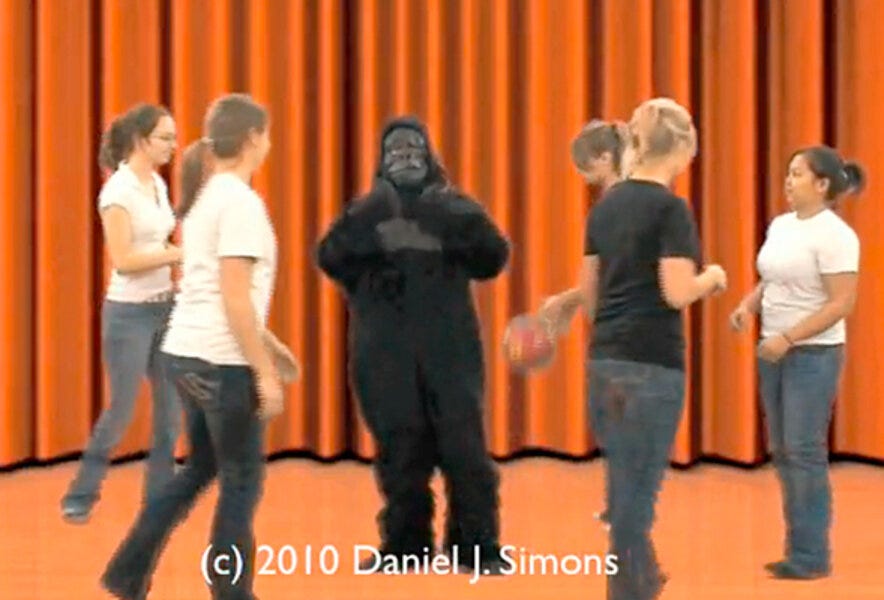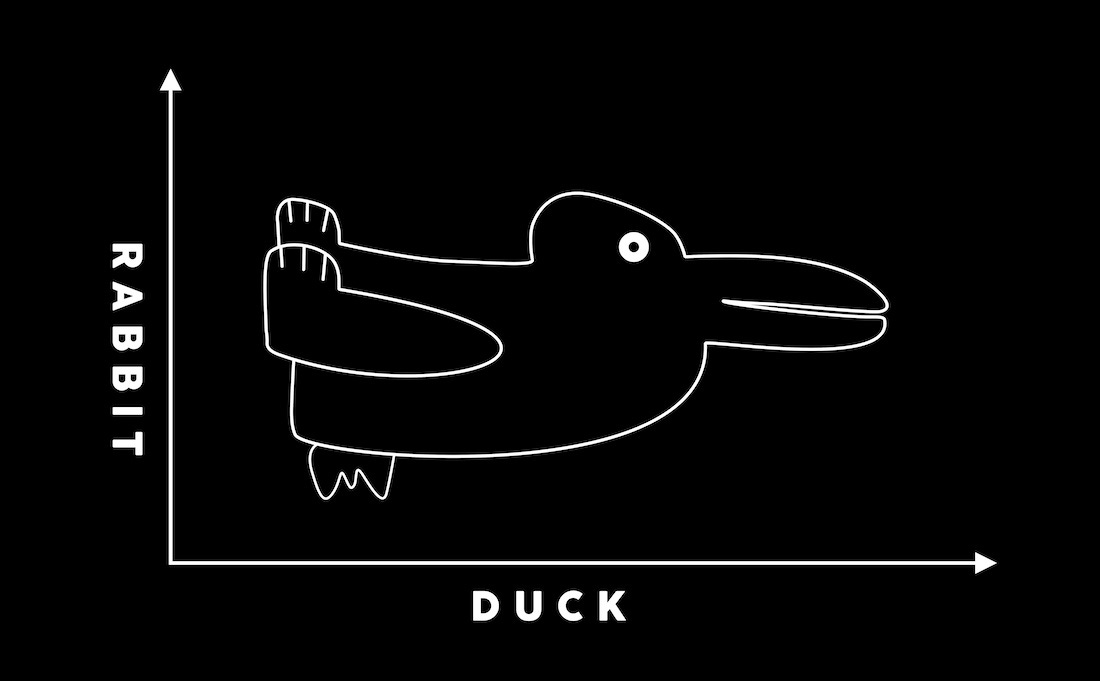Simple(r) Chess : Ask Questions
Sometimes wrong, but never in doubt
Welcome back to Chess in Small Doses! This is the second installment of a series I’m calling Simple(r) Chess. We’re diving into the 5 key habits to playing better chess (at least from my view point). Last time we discussed Habit #5 taking a “time out” before you move as a blunder check. This time we’re talking about Habit #4 asking questions.
Look at the above picture. Does anything stand out as odd? This is a still screen shot from somewhat disturbing cognitive test called the Invisible Gorilla. Dr. Christopher Chabris and Dr. Daniel Simons created an experiment where subjects are asked to watch a video and track the number of basketball passes between one team of players wearing either white or black shirts color shirts. There’s a second team in opposite color shirts doing the same thing. As players move around from both teams passing the ball, you have to pay close attention to see all the passes. In the middle of the test (SPOILER alert) a person wearing a gorilla suit walks through the picture and pounds their chest. Amazingly, over half the people tested didn't see the gorilla even thought they were looking right at it. Their brain filtered out the information right in front of them and they did not remember seeing the gorilla. This test became quite famous in the popular press and coined the term “inattentional blindness” (check out their book here).
I called it disturbing because this test (and others like it) seem to indicate we don’t always remember accurately. When confronted by large amounts of information or sensory input, our brains will filter out what it deems as noise to better focus on other things. Our brains will make split second decisions about what is important and what isn’t, but it’s not perfect. We cannot actually trust what we thought we saw. Even worse, we aren’t always aware that our recall is faulty.
Dr. Chabris is also a USCF Master and has been on Perpetual Chess many times, including this episode discussing “inattentional blindness” in chess. The term simply means we don’t notice (at least consciously) how things have changed. This happens all the time in real life, so much that movie directors don’t bother editing out the continuity errors and simply trust that people will just miss them. And we do, reliably. Our brains evolved during a time where there wasn’t as much information to pay attention to as there is now. When overwhelmed with information, our brains “aren't as good at making sense of and using information as a guide in our decisions” (NPR). Our brains often just ignore it.
We appear to have blindness to how things have changed. Which brings us to chess. Have you ever looked at a position and played a move that looked good, only to realize your mistake immediately after you move? It was like your brain was screaming at you to not play it but you weren’t hearing it? This moment was exactly that for me:
I thought I had just won a pawn with Rxc3 but I felt horror the moment I took my hand off my rook.. As soon as I took the pawn I realized my opponent could play Bxh7+ winning the pawn back and then winning the rook. My brain had seen the pattern clearly, but I just wasn’t aware of it until after I moved. I had simply filtered out the information that was right in front of me.
So what is a chess player to do? Is there anything we can do to become more aware of what we don’t know we’ve missed? Actually, yes there is. The answer comes from Annie Duke’s book Thinking in Bets. There’s a ton of valuable information in that book, but for us the key is how Annie (a professional poker player and PhD in Cognitive Psychology) learned to admit uncertainty and ask “What do you know that I don’t?” That question became the critical step to allow her brain to become open to new information.
Asking questions is the single best way to change the filters on your perception. Once you take a different perspective, different parts of your brain start to work on the information in front of you. For example, look at the picture below.
What you see here depends entirely on how you look at it. Changing your point of view on the object changes what your brain will recognize. That is not just true of special images of optical illusions, but frustratingly it is true of many things we assume are unquestionable. Think of questioning your assumptions as coming to a problem with fresh eyes. As chess players, we need to routinely question or challenge our understanding of the position in front of us.
Now which questions should we ask? Asking any question before you move is a victory in and of itself, but hopefully we pick the right ones to bring new information into focus. Obviously I am no GM, and you’d be well advised to listen to GM Jacob Aaggaard’s advice instead of mine. His list of three questions is solid and easy to remember, but often beyond the level where many adult improvers are at. I know that’s currently true for me. So maybe instead I’ll start with some simpler, more basic questions to ask when looking for a move.
#1) What does the move do (and is it a mistake)?
As GM Ramesh said in his book, Improve Your Calculation, every move has both an upside and a downside (paraphrasing). Can you spot everything a move does every time? Take this position for example:
My opponent here developed his knight to e7, blocking his queen’s control of g5. I noticed this and knew that if he castled short next, the Greek Gift was possible. He could have simply played Ng6 next to prevent it, but instead castled short. I played Bxh6+ after that and went on to win quickly. They don’t all go my way, but this one did.
With each move the game changes, sometimes significantly. As we’ve seen above, it is human nature to sometimes be blind to change. Taking some time to ask the simple question “What has changed?” or “What does that move do?” helps to bring into awareness all the big and small things that have changed. Every move covers and uncovers squares, changes what is controlled and what is uncontrolled. We will get better only when we start to noticed all the things a move does. (I’ll also credit Dan Heisman’s Improving Chess Thinker book for this idea.)
#2) What’s the plan?
One of my amateur weaknesses is trying to start tactical threats before I’m fully developed. Often I get caught up in the flow of the game and will simply forget. It’s not unlike watching a movie and missing all the mistakes because you’re so caught up in the story. I’ve had to learn to bring myself back and reconsider my options. See below:
In this game I was up a pawn and pretty close to fully developed. I just need to castle and centralize the rooks and I’ve got a strong position. Instead, I played Bh4 to eventually contest White’s d3 bishop by moving it to g6. I was really hoping he’d trade there opening the h file. However, if instead I had asked “What’s the plan?” I would looked at the board differently and noticed the pawn storm on the Queenside trying to open the diagonal towards my king still on e8. In that case, maybe I would have castled the king to safety and connected the rooks.
Asking yourself “What’s the plan?” will work for both your side and theirs. In every game now my plan is to get fully developed within 15 moves (barring tactics). After that, my plan is get my pieces active. I have these mini plans to act as prompts or cues. Both of those plans might sound simplistic, but they force me to look for moves that fit the plan. Forgetting to finish development is a real problem for amateurs like me.
However, I also use the question for my opponent’s moves (like Aaggard suggests). The plan for White in the above position is to push b5 and open the Queen side with sort of a reverse minority attack. It’s easy to forget we have an opponent, but asking this simple question can remind us to bring their intent into awareness. Counteracting their plan becomes easier when you see it coming.
#3) What else?
I miss opponents resources all the time. It’s a frustrating habit I have and has led me to lose “won” games far too often. Take this position for example.
It’s White to move here. I had calculated Bxf8 Bxe4 Qxe4 with a double attack on the knight and the remaining rook. I missed that Black had e5, defending both pieces. Instead of just seeing one line, asking myself “what else” can help me help broaden my search for possible moves in the position. Then I might have seen the correct move order was Bxb7. One of the rooks will fall, winning the exchange for White.
Let’s take another position.
My opponent moved Bb5 to force my rook onto e1. I knew his intent was to drop the knight onto d3 and fork my rooks but the bishop on b1 defends it. After Re1 Bd3 my opponent expected me to play Bxd3. If they had asked “what else”, they might have seen Qb3! as the winning move I played. Black went on to lose a pawn and have a knight stuck on the edge of the board and lost the game.
Humans are fallible and error prone. The research that I’ve shared with you today should give us great pause, as it seems that even when we’re certain of something it may not actually be so. Because we are so vulnerable we need to develop the habit of questioning our assumptions and being open to new information. This is true both in chess and in our lives. I hope you can start simply by asking yourself one of these questions the next time you play. I believe it will help your chess greatly.
Thank you for reading Chess in Small Doses. Please leave a comment and share this post if you enjoyed it. Next time we’ll continue the series with Simple(r) Chess and talk about using all the pieces.









Excellent post and ideas to help with blindness..which I am a champion at like a recent OTB tournament game I moved my queen to fork two pieces and as I let go I realized his pawn could just capture my queen..true blindness of the finest.
Dr. V excellent article.. I am always interested in the Psychological aspects of chess...